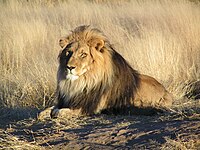
Photo from wikipedia
Food uptake ability of higher trophic level species are more complicated and interesting due to their choice and availability of food and consequently their growth. In the present study, the… Click to show full abstract
Food uptake ability of higher trophic level species are more complicated and interesting due to their choice and availability of food and consequently their growth. In the present study, the effect of top predator interference on the dynamics of a tritrophic food chain model involving an intermediate and a generalist type top predator are considered. It is assumed that the interaction between the logistically growing prey and intermediate predator follows the Volterra scheme, while that between the top predator and its favorite food i.e. the intermediate predator follows Crowley–Martin type functional response. Also, it is considered that the growth of top predator is by sexual reproduction. The boundedness of the system, existence of an attracting set, local and global stability of non-negative equilibrium points and uniform persistence are established by very complicated and highly nonlinear biological considerations. With the help of empirical results from different field and laboratory experiment, it is clarified that Crowley–Martin type functional response gives better result than other predator dependent functional responses for the issue of interference among own population. Also it is clarified from literature survey that high trophic species are mostly generalist type i.e. they can survive rather than their favorite food depending upon the present environmental situation and their growth rate depends upon the mating success. Moreover, increasing the top predator interference stabilizes the system, while increasing the normalization of the residual reduction in the top predator population destabilizes the system. Different numerical examples support these ecological phenomenon.
Journal Title: International Journal of Dynamics and Control
Year Published: 2017
Link to full text (if available)
Share on Social Media: Sign Up to like & get
recommendations!